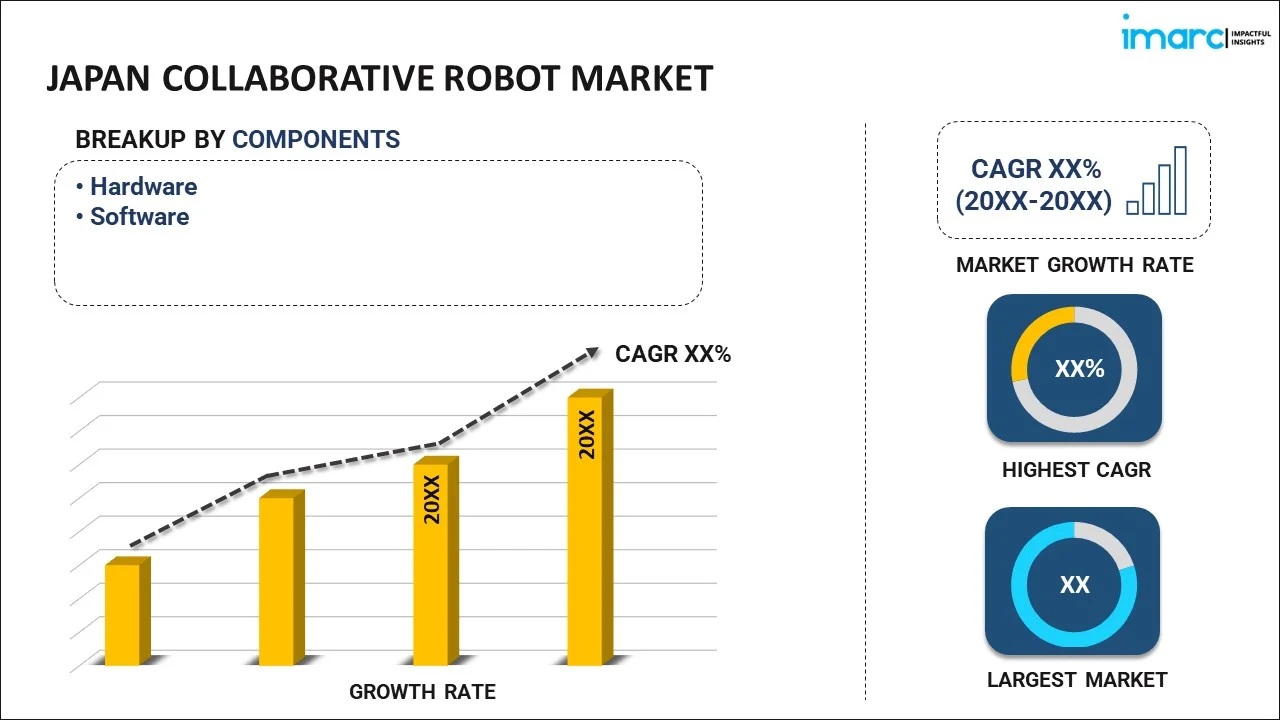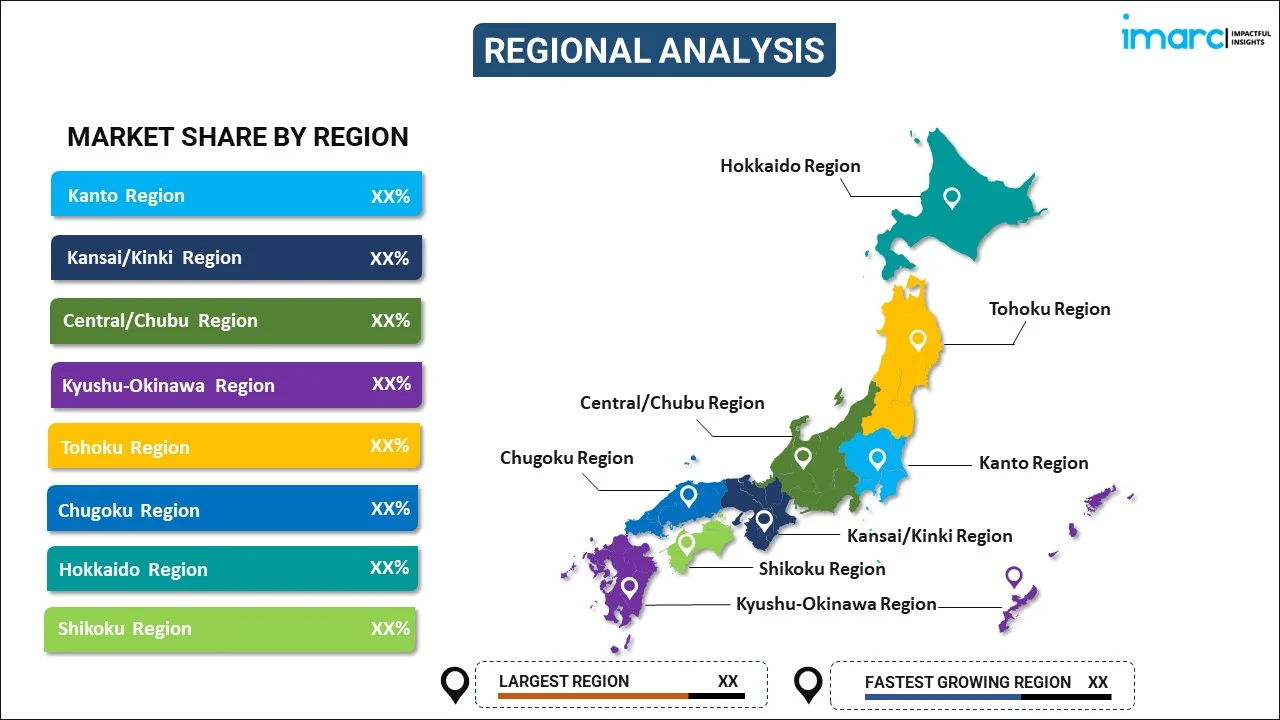
Japan Collaborative Robot Market Report by Component (Hardware, Software), Payload (Up to 5 Kg, 5-10 Kg, Above 10 Kg), Application (Material Handling, Pick and Place, Assembly, Palletizing and De-Palletizing, and Other), End Use Industry (Automotive, Electronics, Manufacturing, Food and Beverage, Chemicals and Pharmaceutical, and Others), and Region 2025-2033
Market Overview:
Japan collaborative robot market size reached USD 536.5 Million in 2024. Looking forward, IMARC Group expects the market to reach USD 15,874.7 Million by 2033, exhibiting a growth rate (CAGR) of 41.4% during 2025-2033. The growing need for complex work processes and multitasking is primarily driving the market growth.
|
Report Attribute
|
Key Statistics
|
|---|---|
|
Base Year
|
2024
|
|
Forecast Years
|
2025-2033
|
|
Historical Years
|
2019-2024
|
| Market Size in 2024 | USD 536.5 Million |
| Market Forecast in 2033 | USD 15,874.7 Million |
| Market Growth Rate 2025-2033 | 41.4% |
A collaborative robot, often referred to as a robot, is an advanced robotic system designed to perform various tasks in cooperation with humans. It utilizes machine vision, cognitive computing, and touch and mobile technologies to gain situational awareness through methods like demonstration and reinforcement learning. Collaborative robots are energy-efficient, consuming less power than larger autonomous robots, and they incorporate collision detection mechanisms to prevent harm to human colleagues. Furthermore, they excel in reducing errors, enhancing productivity, and delivering improved operational outcomes. Consequently, they are widely utilized across industries such as electronics, automotive, manufacturing, and the food and beverage (F&B) sector.
Japan Collaborative Robot Market Trends:
Currently, there is a significant uptick in demand for high-payload capacity collaborative robots, and this trend is mirrored in Japan. This surge aligns with the increasing automation witnessed across various industries, particularly in emerging economies, serving as a primary driver for the market. Furthermore, there is a growing global adoption of torque and force sensing technologies within robotic systems, further intensified by the mounting utilization of collaborative robots in manufacturing applications like assembly lines and welding. This trend fuels market growth. Additionally, there is a rising need for user-friendly robots that don't necessitate a highly specialized workforce to operate, contributing to market expansion. Moreover, the packaging industry's growing requirement for collaborative robots to enhance production rates is a significant stimulant for market development. Furthermore, in the logistics sector, the increasing utilization of collaborative robots to address challenges like complex work processes and multitasking is expected to drive overall sales and profitability. These dynamics are shaping the collaborative robot market in Japan and contributing to its continued growth. Apart from this, as manufacturers seek to minimize human-to-human contact and ensure business continuity, collaborative robots have been deployed for tasks like quality control, material handling, and even cleaning in various industries, which is anticipated to fuel the regional market over the forecasted period.
Japan Collaborative Robot Market Segmentation:
IMARC Group provides an analysis of the key trends in each segment of the market, along with forecasts at the country level for 2025-2033. Our report has categorized the market based on component, payload, application, and end use industry.
Component Insights:

- Hardware
- Software
The report has provided a detailed breakup and analysis of the market based on the component. This includes hardware and software.
Payload Insights:
- Up to 5 Kg
- 5-10 Kg
- Above 10 Kg
A detailed breakup and analysis of the market based on the payload have also been provided in the report. This includes up to 5 kg, 5-10 kg, and above 10 kg.
Application Insights:
- Material Handling
- Pick and Place
- Assembly
- Palletizing and De-Palletizing
- Others
The report has provided a detailed breakup and analysis of the market based on the application. This includes material handling, pick and place, assembly, palletizing and de-palletizing, and others.
End Use Industry Insights:
- Automotive
- Electronics
- Manufacturing
- Food and Beverage
- Chemicals and Pharmaceutical
- Others
A detailed breakup and analysis of the market based on the end use industry have also been provided in the report. This includes automotive, electronics, manufacturing, food and beverage, chemicals and pharmaceutical, and others.
Regional Insights:

- Kanto Region
- Kansai/Kinki Region
- Central/ Chubu Region
- Kyushu-Okinawa Region
- Tohoku Region
- Chugoku Region
- Hokkaido Region
- Shikoku Region
The report has also provided a comprehensive analysis of all the major regional markets, which include Kanto Region, Kansai/Kinki Region, Central/ Chubu Region, Kyushu-Okinawa Region, Tohoku Region, Chugoku Region, Hokkaido Region, and Shikoku Region.
Competitive Landscape:
The market research report has also provided a comprehensive analysis of the competitive landscape in the market. Competitive analysis such as market structure, key player positioning, top winning strategies, competitive dashboard, and company evaluation quadrant has been covered in the report. Also, detailed profiles of all major companies have been provided.
Japan Collaborative Robot Market Report Coverage:
| Report Features | Details |
|---|---|
| Base Year of the Analysis | 2024 |
| Historical Period | 2019-2024 |
| Forecast Period | 2025-2033 |
| Units | Million USD |
| Scope of the Report | Exploration of Historical Trends and Market Outlook, Industry Catalysts and Challenges, Segment-Wise Historical and Future Market Assessment:
|
| Components Covered | Hardware, Software |
| Payloads Covered | Up to 5 Kg, 5-10 Kg, Above 10 Kg |
| Applications Covered | Material Handling, Pick and Place, Assembly, Palletizing and De-Palletizing, Others |
| End Use Industries Covered | Automotive, Electronics, Manufacturing, Food and Beverage, Chemicals and Pharmaceutical, Others |
| Regions Covered | Kanto Region, Kansai/Kinki Region, Central/ Chubu Region, Kyushu-Okinawa Region, Tohoku Region, Chugoku Region, Hokkaido Region, Shikoku Region |
| Customization Scope | 10% Free Customization |
| Post-Sale Analyst Support | 10-12 Weeks |
| Delivery Format | PDF and Excel through Email (We can also provide the editable version of the report in PPT/Word format on special request) |
Key Questions Answered in This Report:
- How has the Japan collaborative robot market performed so far and how will it perform in the coming years?
- What has been the impact of COVID-19 on the Japan collaborative robot market?
- What is the breakup of the Japan collaborative robot market on the basis of component?
- What is the breakup of the Japan collaborative robot market on the basis of payload?
- What is the breakup of the Japan collaborative robot market on the basis of application?
- What is the breakup of the Japan collaborative robot market on the basis of end use industry?
- What are the various stages in the value chain of the Japan collaborative robot market?
- What are the key driving factors and challenges in the Japan collaborative robot?
- What is the structure of the Japan collaborative robot market and who are the key players?
- What is the degree of competition in the Japan collaborative robot market?
Key Benefits for Stakeholders:
- IMARC’s industry report offers a comprehensive quantitative analysis of various market segments, historical and current market trends, market forecasts, and dynamics of the Japan collaborative robot market from 2019-2033.
- The research report provides the latest information on the market drivers, challenges, and opportunities in the Japan collaborative robot market.
- Porter's five forces analysis assist stakeholders in assessing the impact of new entrants, competitive rivalry, supplier power, buyer power, and the threat of substitution. It helps stakeholders to analyze the level of competition within the Japan collaborative robot industry and its attractiveness.
- Competitive landscape allows stakeholders to understand their competitive environment and provides an insight into the current positions of key players in the market.
Need more help?
- Speak to our experienced analysts for insights on the current market scenarios.
- Include additional segments and countries to customize the report as per your requirement.
- Gain an unparalleled competitive advantage in your domain by understanding how to utilize the report and positively impacting your operations and revenue.
- For further assistance, please connect with our analysts.
 Inquire Before Buying
Inquire Before Buying
 Speak to an Analyst
Speak to an Analyst
 Request Brochure
Request Brochure
 Request Customization
Request Customization




.webp)




.webp)












